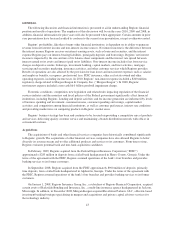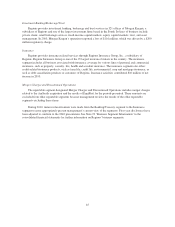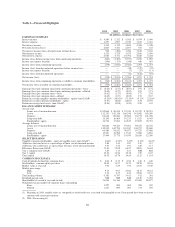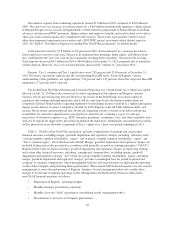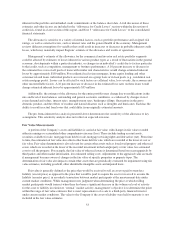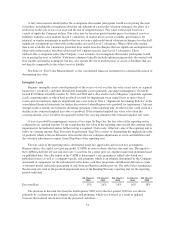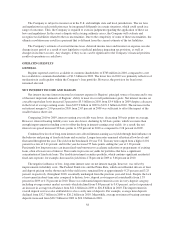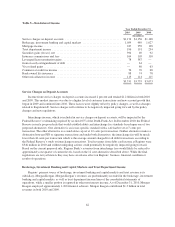Regions Bank 2010 Annual Report Download - page 67
Download and view the complete annual report
Please find page 67 of the 2010 Regions Bank annual report below. You can navigate through the pages in the report by either clicking on the pages listed below, or by using the keyword search tool below to find specific information within the annual report.inherent in the portfolio and unfunded credit commitments at the balance sheet date. A full discussion of these
estimates and other factors are included in the “Allowance for Credit Losses” section within the discussion of
credit risk, found in a later section of this report, and Note 5 “Allowance for Credit Losses” to the consolidated
financial statements.
The allowance is sensitive to a variety of internal factors, such as portfolio performance and assigned risk
ratings, as well as external factors, such as interest rates and the general health of the economy. Management
reviews different assumptions for variables that could result in increases or decreases in probable inherent credit
losses, which may materially impact Regions’ estimate of the allowance and results of operations.
Management’s estimate of the allowance for the commercial and investor real estate portfolio segments
could be affected by estimates of losses inherent in various product types as a result of fluctuations in the general
economy, developments within a particular industry, or changes in an individual’s credit due to factors particular
to that credit, such as competition, management or business performance. A 10 percent increase or decrease in
the estimated loss rates on all pools of loans with similar risk characteristics would change estimated inherent
losses by approximately $180 million. For residential real estate mortgages, home equity lending and other
consumer-related loans, individual products are reviewed on a group basis or in loan pools (e.g., residential real
estate mortgage pools). Losses can be affected by such factors as collateral value, loss severity, the economy and
other uncontrollable factors. A 10 percent increase or decrease in the estimated loss rates on these loans would
change estimated inherent losses by approximately $55 million.
Additionally, the estimate of the allowance for the entire portfolio may change due to modifications in the
mix and level of loan balances outstanding and general economic conditions, as evidenced by changes in real
estate demand and values, interest rates, unemployment rates, bankruptcy filings, fluctuations in the gross
domestic product, and the effects of weather and natural disasters such as droughts and hurricanes. Each has the
ability to result in actual loan losses that could differ from originally estimated amounts.
The pro forma inherent loss analysis presented above demonstrates the sensitivity of the allowance to key
assumptions. This sensitivity analysis does not reflect an expected outcome.
Fair Value Measurements
A portion of the Company’s assets and liabilities is carried at fair value, with changes in fair value recorded
either in earnings or accumulated other comprehensive income (loss). These include trading account assets,
securities available for sale, mortgage loans held for sale, mortgage servicing rights and derivatives (net). From time
to time, the estimation of fair value also affects other loans held for sale, which are recorded at the lower of cost or
fair value. Fair value determination is also relevant for certain other assets such as foreclosed property and other real
estate, which are recorded at the lower of the recorded investment in the loan/property or fair value, less estimated
costs to sell the property. For example, the fair value of other real estate is determined based on recent appraisals by
third parties and other market information, less estimated selling costs. Adjustments to the appraised value are made
if management becomes aware of changes in the fair value of specific properties or property types. The
determination of fair value also impacts certain other assets that are periodically evaluated for impairment using fair
value estimates, including goodwill, other identifiable intangible assets and impaired loans.
Fair value is generally defined as the price that would be received to sell an asset or paid to transfer a
liability (an exit price) as opposed to the price that would be paid to acquire the asset or received to assume the
liability (an entry price), in an orderly transaction between market participants at the measurement date under
current market conditions. While management uses judgment when determining the price at which willing
market participants would transact when there has been a significant decrease in the volume or level of activity
for the asset or liability in relation to “normal” market activity, management’s objective is to determine the point
within the range of fair value estimates that is most representative of a sale to a third-party financial investor
under current market conditions. The value to the Company if the asset or liability were held to maturity is not
included in the fair value estimates.
53


